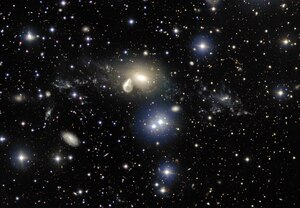
The M81 Group is a galaxy group in the constellations Ursa Major and Camelopardalis that includes the galaxies Messier 81 and Messier 82, as well as several other galaxies with high apparent brightnesses. The approximate center of the group is located at a distance of 3.6 Mpc, making it one of the nearest groups to the Local Group. The group is estimated to have a total mass of ×1012M☉. The M81 Group, the Local Group, and other nearby groups all lie within the Virgo Supercluster.

Centaurus A is a galaxy in the constellation of Centaurus. It was discovered in 1826 by Scottish astronomer James Dunlop from his home in Parramatta, in New South Wales, Australia. There is considerable debate in the literature regarding the galaxy's fundamental properties such as its Hubble type and distance. NGC 5128 is one of the closest radio galaxies to Earth, so its active galactic nucleus has been extensively studied by professional astronomers. The galaxy is also the fifth-brightest in the sky, making it an ideal amateur astronomy target. It is only visible from the southern hemisphere and low northern latitudes.
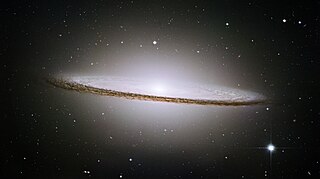
The Sombrero Galaxy is a peculiar galaxy of unclear classification in the constellation borders of Virgo and Corvus, being about 9.55 megaparsecs from the Milky Way galaxy. It is a member of the Virgo II Groups, a series of galaxies and galaxy clusters strung out from the southern edge of the Virgo Supercluster. It has an isophotal diameter of approximately 29.09 to 32.32 kiloparsecs, making it slightly bigger in size than the Milky Way.

Messier 63 or M63, also known as NGC 5055 or the seldom-used Sunflower Galaxy, is a spiral galaxy in the northern constellation of Canes Venatici with approximately 400 billion stars. M63 was first discovered by the French astronomer Pierre Méchain, then later verified by his colleague Charles Messier on June 14, 1779. The galaxy became listed as object 63 in the Messier Catalogue. In the mid-19th century, Anglo-Irish astronomer Lord Rosse identified spiral structures within the galaxy, making this one of the first galaxies in which such structure was identified.
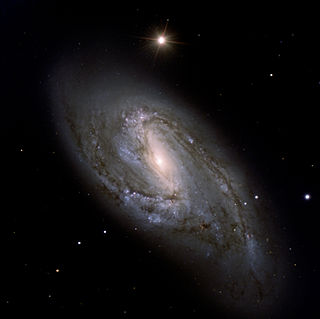
Messier 66 or M66, also known as NGC 3627, is an intermediate spiral galaxy in the southern, equatorial half of Leo. It was discovered by French astronomer Charles Messier on 1 March 1780, who described it as "very long and very faint". This galaxy is a member of a small group of galaxies that includes M65 and NGC 3628, known as the Leo Triplet or the M66 Group. M65 and M66 are a common object for amateur astronomic observation, being separated by only 20′.
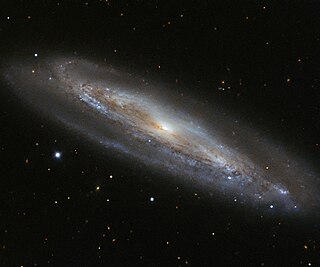
Messier 98, M98 or NGC 4192, is an intermediate spiral galaxy about 44.4 million light-years away in slightly northerly Coma Berenices, about 6° to the east of the bright star Denebola. It was discovered by French astronomer Pierre Méchain on 1781, along with nearby M99 and M100, and was catalogued by compatriot Charles Messier 29 days later in his Catalogue des Nébuleuses & des amas d'Étoiles. It has a blueshift, denoting ignoring of its fast other movement, it is approaching at about 140 km/s.

Messier 108 is a barred spiral galaxy about 28 million light-years away from Earth in the northern constellation Ursa Major. It was discovered by Pierre Méchain in 1781 or 1782. From the Earth, this galaxy is seen almost edge-on.
VIRGOHI21 is an extended region of neutral hydrogen (HI) in the Virgo cluster discovered in 2005. Analysis of its internal motion indicates that it may contain a large amount of dark matter, as much as a small galaxy. Since VIRGOHI21 apparently contains no stars, this would make it one of the first detected dark galaxies. Skeptics of this interpretation argue that VIRGOHI21 is simply a tidal tail of the nearby galaxy NGC 4254.
A dark galaxy is a hypothesized galaxy with no stars. They received their name because they have no visible stars but may be detectable if they contain significant amounts of gas. Astronomers have long theorized the existence of dark galaxies, but there are no confirmed examples to date. Dark galaxies are distinct from intergalactic gas clouds caused by galactic tidal interactions, since these gas clouds do not contain dark matter, so they do not technically qualify as galaxies. Distinguishing between intergalactic gas clouds and galaxies is difficult; most candidate dark galaxies turn out to be tidal gas clouds. The best candidate dark galaxies to date include HI1225+01, AGC229385, and numerous gas clouds detected in studies of quasars.

NGC 1705 is a peculiar lenticular galaxy and a blue compact dwarf galaxy (BCD) in the southern constellation of Pictor, positioned less than a degree to the east of Iota Pictoris, and is undergoing a starburst. With an apparent visual magnitude of 12.6 it requires a telescope to observe. It is estimated to be approximately 17 million light-years from the Earth, and is a member of the Dorado Group.

The Eyes Galaxies are a pair of galaxies about 52 million light-years away in the constellation Virgo. The pair are members of the string of galaxies known as Markarian's Chain.
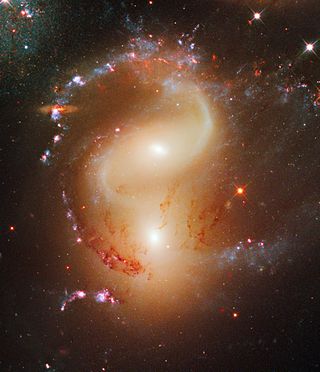
NGC 7318 is a pair of colliding galaxies about 280 million light-years from Earth. They appear in the Constellation Pegasus and are members of Stephan's Quintet.
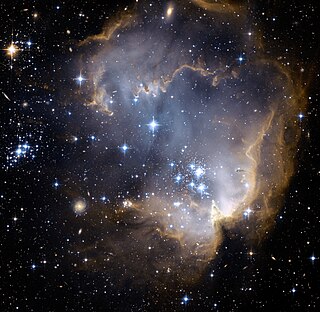
NGC 602 is a young, bright open cluster of stars located in the Small Magellanic Cloud (SMC), a satellite galaxy to the Milky Way. It is embedded in a nebula known as N90.

NGC 4536 is an intermediate spiral galaxy in the constellation Virgo located about 10° south of the midpoint of the Virgo cluster. However, it is not considered a member of the cluster. Rather, it is a member of the M61 Group of galaxies, which is a member of the Virgo II Groups, a series of galaxies and galaxy clusters strung out from the southern edge of the Virgo Supercluster. The morphological classification in the De Vaucouleurs system is SAB(rs)bc, which indicates it is a weakly barred spiral galaxy with a hint of an inner ring structure plus moderate to loosely wound arms. It does not have a classical bulge around the nucleus.

NGC 1566, sometimes known as the Spanish Dancer, is an intermediate spiral galaxy in the constellation Dorado, positioned about 3.5° to the south of the star Gamma Doradus. It was discovered on May 28, 1826 by Scottish astronomer James Dunlop. At 10th magnitude, it requires a telescope to view. The distance to this galaxy remains elusive, with measurements ranging from 6 Mpc up to 21 Mpc.
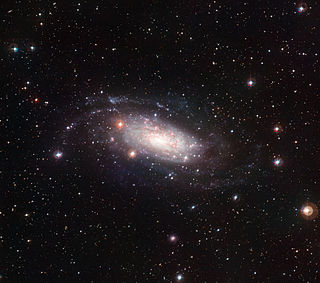
NGC 3621 is a field spiral galaxy about 22 Mly (6.7 Mpc) away in the equatorial constellation of Hydra. It is comparatively bright and can be well seen in moderate-sized telescopes. The galaxy is around 93,000 ly (29,000 pc) across and is inclined at an angle of 25° from being viewed edge on. It shines with a luminosity equal to 13 billion times that of the Sun. The morphological classification is SA(s)d, which indicates this is an ordinary spiral with loosely wound arms. There is no evidence for a bulge. Although it appears to be isolated, NGC 3621 belongs to the Leo spur.
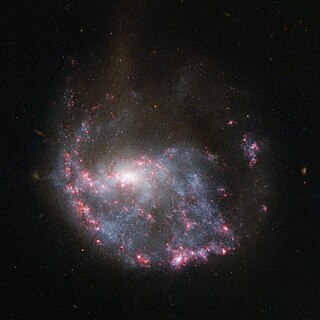
NGC 922 is a peculiar galaxy in the southern constellation of Fornax, located at a distance of 142 Mly from the Milky Way. It is one of the nearest known collisional galaxies. This object was described by the Herschels as "considerably faint, pretty large, round, gradually pretty much brighter middle." The general form is described by the morphological classification of SB(s)cd pec, which indicates a peculiar (pec) barred spiral galaxy (SB) with no inner ring system around the bar (s) and loosely-wound spiral arms (cd).

NGC 4030 is a grand design spiral galaxy located about 64 million light years away in the constellation Virgo. It is a member of the NGC 4030 Group of galaxies, which is a member of the Virgo II Groups, a series of galaxies and galaxy clusters strung out from the southern edge of the Virgo Supercluster. With an apparent visual magnitude of 10.6, it is visible with a small telescope as a 3 arc minute wide feature about 4.75° to the southeast of the star Beta Virginis. It is inclined by an angle of 47.1° to the line of sight from the Earth and is receding at a velocity of 1,465 km/s.
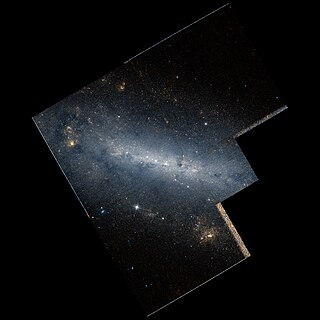
NGC 672 is a spiral galaxy in the northern constellation of Triangulum, positioned around 2° to the southwest of the star Alpha Trianguli. The original object designated NGC 672 was discovered by the German-born astronomer William Herschel on 26 October 1786, but this was later cataloged as NGC 614. The object now identified as NGC 672 was discovered by John Herschel on 11 November 1827.
